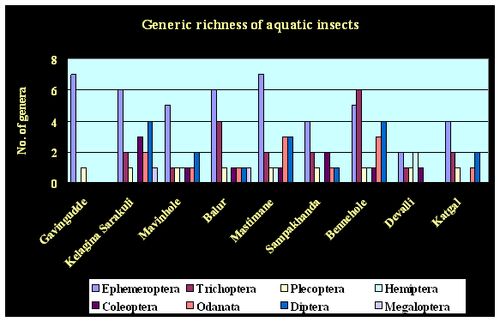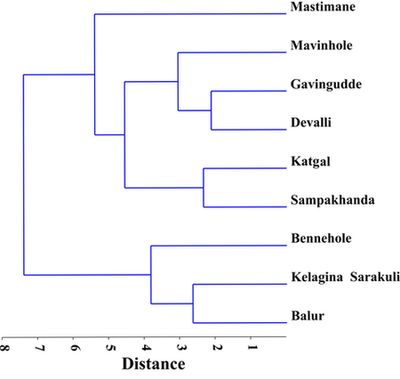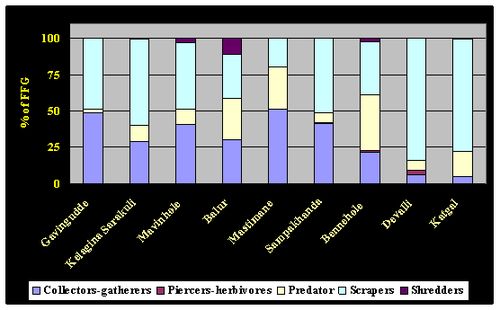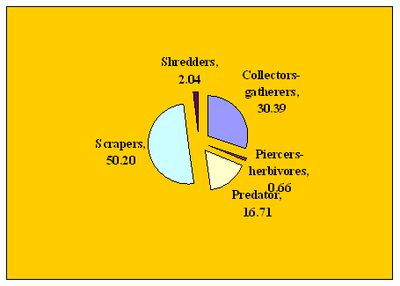|
RESULTS AND DISCUSSION
Altogether 1223 individuals of aquatic insects were collected during the study period from nine sampling stations in Aghanashini River. These belong to 38 genera under 28 families and 8 orders (Table 2). Generic richness of aquatic insects was highest (21) in Bennehole sampling station and decreased towards Kelagina Sarkuli (19), Mastimane (18), Balur (15), Mavinhole (12), Sampakhanda (11), Katgal (10), Gavingudde (8) and Devalli (7) (Figure 2). Ephemeoptera (15) was found to be the predominant group in the studied sites followed by Coleoptera, Trichoptera, Diptera (6), Odanata (4), Hemiptera (2), Plecoptera and Megaloptera (1). Two of the 38 genera, Neoperla and Choroterpes, were found to be present in all sampling sites, whereas 14 genera [Notophlebia, Edmundsula, Petersula, Ephemerella (Torleya), Ephemerella (Drunella), Clypocaenis, Wormaldia, Stenocolus, Dineutus, Laccobius, Heliogomphus, Lamelligomphus and Hexatoma] had single station distribution only. Eleven genera (Helicopsyche, Thraulus, Isca, Thalerosphyrus, Caenis, Psychomyia, Micronecta, Orectochilus, Crocothemis, Coridalus) had presence in two stations each. The genera Cinygmina, Naucoris, Pilaria, Chironomus and Isonychia occurred in three sampling stations each, whereas Afronurus, Platybaetis, Cheumatopsyche, Lepidostoma occurred in four stations each. A single genus Eubrianax was found in five out of nine stations while two genera Euphaea and Simulium occurred in six stations. The genera Hydropsyche and Baetis were found to be present in seven and eight sampling stations respectively.

Figure 2: Generic richness of aquatic insect orders in sampling stations of Aghanashini River.
Table 2: Functional Feeding Group-wise classification of insects in Aghanashini River
| Order |
Family |
Genus |
Functional Feeding Group |
| Ephemeroptera |
Isonychidae |
Isonychia sp |
Collectors-filterers |
| Leptophelebiidae |
Choroterpes sp |
Scrapers |
| Thraulus sp. |
Collectors |
| Isca sp. |
Collectors |
| Notophlebia sp. |
Collectors |
| Edmundsula sp. |
Collectors |
| Petersula sp. |
Collectors |
| Heptageniidae |
Afronurus sp. |
Scrapers |
| Thalerosphyrus sp. |
Scrapers |
| Cinygmina sp. |
Collectors |
| Ephemerellidae |
Ephemerella (Torleya) sp. |
Collectors |
| Ephemerella (Drunella) sp. |
Collectors |
| Baetidae |
Baetis sp. |
Scrapers |
| Platybaetis sp. |
Scrapers |
| Caenidae |
Caenis sp. |
Collectors-gatherers |
| Clypocaenis bisetosa |
Collectors-filterers |
| Trichoptera |
Hydropsychidae |
Cheumatopsyche sp. |
Collectors-filterers |
| Hydropsyche sp. |
Collectors-filterers |
| Lepidostomatidae |
Lepidostoma sp. |
Shredders |
| Helicopsychidae |
Helicopsyche sp. |
Scrapers |
| Psychomyiidae |
Psychomyia sp. |
Collectors-gatherers |
| Philopotamidae |
Wormaldia sp. |
Collectors-filterers |
| Plecoptera |
Perlidae |
Neoperla sp. |
Predator |
| Hemiptera |
Naucoridae |
Naucoris sp. |
Predator |
| Corixidae |
Micronecta sp. |
Piercers-herbivores |
| Coleoptera |
Psephenidae |
Eubrianax sp. |
Scrapers |
| Noteridae |
Noterus sp |
Predator |
| Ptilodactylidae |
Stenocolus |
Shredders |
| Gyrinidae |
Dineutus sp. |
Predator |
| Orectochilus sp |
Predator |
| Hydrophilidae |
Laccobius sp. |
Piercers-herbivores |
| Odanata |
Euphaeidae |
Euphaea sp |
Predator |
| Gomphidae |
Heliogomphus sp. |
Predator |
| Lamelligomphus sp. |
Predator |
| Libelluidae |
Crocothemis sp. |
Predator |
| Aeshnidae |
UN |
Predator |
| Diptera |
Tipulidae |
Hexatoma sp. |
Predator |
| Pilaria sp. |
Predator |
| Tapanidae |
UN |
|
| Chironomidae |
Chironomus sp. |
Collectors-gatherers |
| Simulidae |
Simulium sp. |
Collectors |
| Ephydridae |
UN |
Scrapers |
| Megaloptera |
Coridalidae |
Coridalus sp. |
Predator |
The Shannon and Simpson diversity indices were highest at Bennehole (2.754 and 0.9142) and lowest at Katgal (0.852) and Devalli (0.3799) respectively. The Evenness and Margalef indices were highest at Balur (0.7772) and Bennehole (4.662) and lowest at Katgal (0.2344) and Devalli (1.237) respectively (Table 1). Aquatic insect diversity of Aghanashini river system is comparatively higher when compared to other well studied river systems such as Sharavathi in Uttara Kannada (Ramachandra et al., 2002), Kunthipuzha in Silent Valley in Kerala (Burton and Sivaramkrishanan), Tamiraparani River in Tamil Nadu (Martin, 2000) and Yamuna River studied in Firozabad district in Uttar Pradesh by Gupta and Paliwal (2010). The highest richness and diversity values were observed for Bennehole, Kelagina Sarkuli and Mastimane areas. High numerical abundance of the more organic pollution tolerant Baetis and Hydropsyche in the downstream sampling stations Devalli and Katgal is indicative of higher human disturbances. Families Hydropsychidae (to which Hydropsyche belongs) and Baetidae (of genus Baetis)are known to be tolerant towards organic pollution and other human disturbances (Sivaramakrishanan, 1996, Selvakumar et al., 2012).
Table 1: Species richness and diversity indices for aquatic insects in sampling stations
| Sampling station |
Taxa |
Simpson |
Shannon |
Evenness |
Margalef |
| Gavingudde |
8 |
0.7272 |
1.565 |
0.5976 |
1.556 |
| Kelagina Sarakuli |
19 |
0.7794 |
1.946 |
0.3686 |
3.140 |
| Mavinhole |
12 |
0.8311 |
2.071 |
0.6609 |
2.439 |
| Balur |
15 |
0.8940 |
2.456 |
0.7772 |
3.263 |
| Mastimane |
18 |
0.9019 |
2.557 |
0.7169 |
3.837 |
| Sampakhanda |
11 |
0.6703 |
1.473 |
0.3965 |
2.012 |
| Bennehole |
21 |
0.9142 |
2.754 |
0.7475 |
4.662 |
| Devalli |
7 |
0.3799 |
0.891 |
0.3483 |
1.237 |
| Katgal |
10 |
0.3988 |
0.852 |
0.2344 |
1.645 |
Based on Ward’s method of distance, 9 sampling stations were clustered into two major groups (Figure 3). Balur, Kelagina Sarkuli and Bennehole formed one group and the remaining 6 sites formed the second group. In the second group, the sampling station of Mastimane differed from other sampling stations. The first group was mainly clustered with higher taxa distribution ranging from 15 to 21 for each station; this taxa rich cluster is significant for the presence of sensitive genera like Isonychia, Helicopsyche, Isca and Neoperla. In the second group of six stations five had low diversity (7-12 genera); the station Mastimane towards the foothills showed higher diversity (18 genera) due to the combined presence of pollution sensitive genera and tolerant ones indicative of moderate disturbances. Notable sensitive organisms found here were Notophlebia, Edmundsula, Afronurus, Ephemerella (Torleya) and Clypocaenis. Rest of the sampling sites of second group with 7 to 12 taxa each, had all cosmopolitan taxa like Baetis, Choroterpes, Neoperla, Platybaetis, Eubrianax, Orectochilus, Euphaea, and Simulium. The results of cluster analysis on Ward’s methods of distance clearly showed close variance between the Bennehole, Kelagina Sarkuli and Balur sampling stations, indicating similarity in species composition due to similar stream vegetation profile. The aquatic insect taxa like Helicopsyche, Petersula, Isca and Isonychia are intolerant to pollution and habitat disturbance, and hence, their presence indicates pristine habitats including the rich forests adjoining these stations.

Figure 3: Cluster analysis for sampling sites based on Ward’s method of distance
Functional feeding groups of aquatic insects are shown in Figures 4 and 5. Scraper (50.2 %) was the predominant group in this river followed by collectors (30.39 %), predators (16.71 %), shredders (2.04 %) and piercers (herbivores) (0.66 %). Scraper group population was most abundant in the downstream of river at Devalli (84.38 %) and least abundant at Mastimane (19.51 %). The collector group was dominant at Mastimane and least abundant at Devalli, whereas, the predator group was found to be dominant in Bennehole and least abundant at Sampakhanda and Devalli. The River Continuum Concept (RCC) states that rivers have physical gradients which are influenced by the surrounding environment; natural disturbance regime, local hydrology and upstream conditions in turn impact and define the biological components of the stream (Vannote et al., 1980). Similarly, numerous studies suggest that stream invertebrates demonstrate preferential feeding, which depends on the food resources available (Chaloner and Wipfli, 2002, Burrell and Ledger 2003). However, the classification of stream invertebrates into functional feeding groups is a useful tool that enhances our understanding of stream nutrient cycling and trophic interactions, which impact stream integrity and function. According to RCC, the members of shredder community are predominant in the upstream of riverine ecosystem, gradually decreasing towards downstream, where collectors and collector gatherers become dominant. In the present study, the shredder community was sufficiently represented in the upstream areas. Shredding of fallen plant materials in the stream is pre-requisite for microbial degradation for the furtherance of the nutrient cycle in water. Whereas the absence of shredders in the downstream stations is in conformity with the RCC, their scarcity in the upstream areas highlights the need and for yearlong surveys so as to get full profile of the functioning of stream aquatic foodwebs.

Figure 4: Percentage of Functional Feeding Group of aquatic insects in the sampling stations of Aghanashini River

Figure 5: Percentage composition of Functional Feeding Group in Aghanashini River
|





